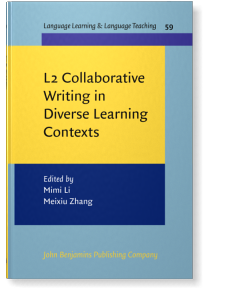L2 Collaborative Writing in Diverse Learning Contexts
Editors
This book is the first edited volume to compile up-to-date scholarship that discusses frontier knowledge on second language (L2) collaborative writing (CW) and highlights technology-mediated solutions to it. The volume consists of conceptual papers and empirical studies that explore theoretical, methodological, and pedagogical approaches to CW in face-to-face, online, and hybrid learning contexts. The ten chapters of the book are divided into three sections: (1) theoretical perspectives and a methodological review of CW; (2) empirical research addressing the processes, products, and effects pertaining to CW; (3) pedagogical aspects relevant to CW, namely task design, technology use, and assessment. By examining the implementation of various CW tasks across modes, genres, and L2 learning settings, this book re-evaluates the practices of CW and illustrates how diverse forms of CW can facilitate students’ L2 learning and writing development.
[Language Learning & Language Teaching, 59] 2023. vii, 253 pp.
Publishing status:
© John Benjamins
Table of Contents
-
Acknowledgments | pp. vii–7
-
IntroductionMimi Li and Meixiu Zhang | pp. 1–10
-
Section I. Theoretical and methodological perspectives of collaborative writing
-
Chapter 1. Sociocultural approaches to L2 digital collaborative writingIdoia Elola and Ana Oskoz | pp. 12–31
-
Chapter 2. Metacognitive approaches to collaborative writing: Theoretical and pedagogical proposalsMasatoshi Sato | pp. 32–52
-
Chapter 3. Collaborative writing in face-to-face and computer-mediated L2 settings: A methodological perspectiveMeixiu Zhang and Mimi Li | pp. 53–77
-
Section II. Empirical research on face-to-face and computer-mediated collaborative writing
-
Chapter 4. Do task repetition and pretask focus on form instruction impact collaborative writing performance? Evidence from young learnersAsier Calzada and María del Pilar García Mayo | pp. 80–108
-
Chapter 5. Examining the role of peer collaborative feedback processing and task repetition in task-based L2 writingZsuzsanna Abrams | pp. 109–129
-
Chapter 6. Online collaborative L2 writing: Using synchronous and asynchronous tools with Arabic as a second language learnersHanan Almalki and Neomy Storch | pp. 130–154
-
Chapter 7. Peer interaction in collaborative L2 writing across synchronous and asynchronous CMC modesHsiu-Chen Hsu | pp. 155–180
-
Section III. Pedagogical practices of collaborative writing in the digital age
-
Chapter 8. Designing collaborative writing tasks for face-to-face and computer-mediated communication contextsMatt Kessler | pp. 184–201
-
Chapter 9. Use of digital technologies for collaborative writingJohn Gibbons and Miriam Akoto | pp. 202–228
-
Chapter 10. Assessing collaborative writing: Current challenges and future possibilitiesNeomy Storch and Ute Knoch | pp. 229–247
-
Index | pp. 249–253
Cited by (1)
Cited by one other publication
This list is based on CrossRef data as of 3 july 2024. Please note that it may not be complete. Sources presented here have been supplied by the respective publishers. Any errors therein should be reported to them.
Subjects
Main BIC Subject
CJA: Language teaching theory & methods
Main BISAC Subject
LAN020000: LANGUAGE ARTS & DISCIPLINES / Study & Teaching

